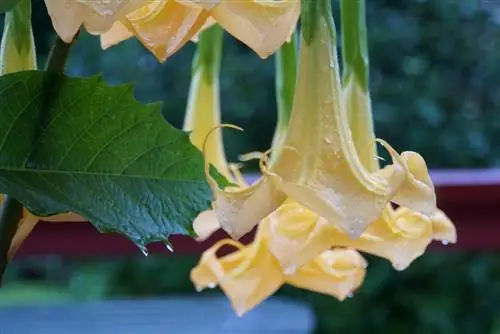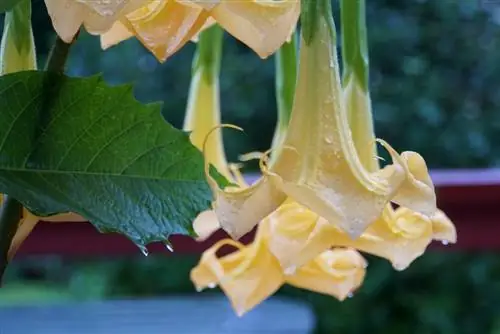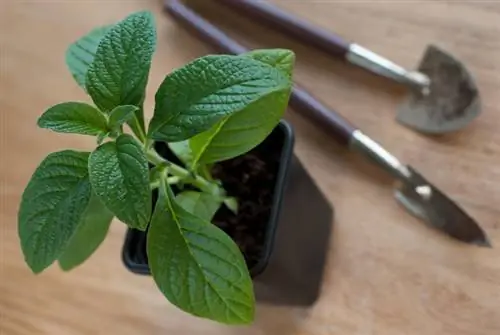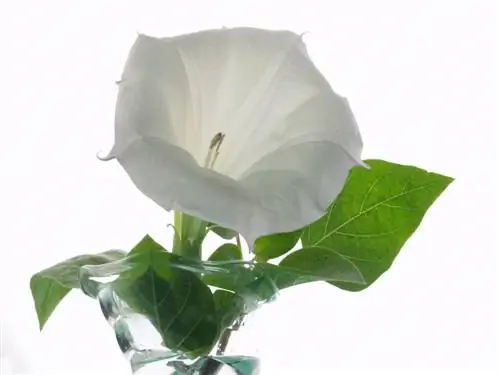- Author admin [email protected].
- Public 2023-12-16 16:46.
- Last modified 2025-01-23 11:21.
In order to cultivate an angel's trumpet to its famous splendor, as a hobby gardener you have to invest a little work. The beauty of the Andes is not that easy - read below which care measures are essential for successful cultivation.

How do I properly care for an angel trumpet?
The optimal care of an angel's trumpet includes regular watering, especially on warm days, the use of calcareous water, nutrient-rich substrate, fertilizing with nitrogen and potassium-containing fertilizers, moderate pruning and a mild wintering at 10-18°C.
What angel trumpets want
The most important thing when caring for angel trumpets is:
- watering and
- nutrient intake
Pouring, pouring, pouring
The angel's trumpet, scientifically Brugmansia, comes from the South American Andes. In this country it is only too popular to grow because of its magnificent flowers - but its original origin brings with it some demands when it comes to cultivation here. On the one hand, its highly evaporative, surface-rich leaves make it an extremely thirsty plant and in this country it has to be kept in a pot due to its sensitivity to cold. This combination involves a lot of casting work.
It is advisable to water the angel's trumpet daily throughout the main vegetation phase from spring to summer. Each time you do this, wait for the water to come out of the drain holes at the bottom of the bucket and run into the saucer. On particularly warm days in summer, the angel's trumpet literally becomes a drunkard. Here you should water them vigorously at least twice a day.
If your tap water contains lime, use this for watering, because the angel's trumpet loves lime.
Fertilizing is mandatory
On the other hand, as a nightshade plant, it has the typical characteristic of being a heavy feeder. So it not only needs a lot to drink, but also a lot of nutrients in order to thrive. A rich substrate and continuous fertilization are also necessary.
First of all, you should offer the angel's trumpet a voluminous substrate in a large pot. Fill this with potted plant soil and ensure good water drainage with an underlayer of expanded clay. You should also treat it to a new, larger pot after the winter break and enrich the substrate with slow-release fertilizer. This will avoid acute deficiency conditions throughout the vegetation phase.
In addition, you should supply the plant with a nitrogen-containing growth fertilizer (€39.00 on Amazon) about twice a week in spring. This means it develops strong growth and is well prepared for the strenuous flowering phase. You can also use special liquid fertilizer for angel trumpets.
As soon as the first flowering appears, switch to potassium-containing flowering fertilizer for potted plants, which can increase the joy of flowers.
Cutting and overwintering
Pruning and overwintering are two more interesting chapters on the subject of angel trumpet care.
Moderate cut
There isn't much to consider when it comes to cutting. Before wintering, you can cut the plant back a little, but you shouldn't do it too radically. The less you prune, the more abundant the flowers will be the following season. So only shorten the outer, forked shoots.
Relatively mild winter
The angel's trumpet's wintering quarters can be either light or dark. Depending on the light, the optimal temperature is a very mild 12 to 18°C in bright locations or around 10°C in dark locations. During the winter break, water only enough to prevent the root ball from drying out.






